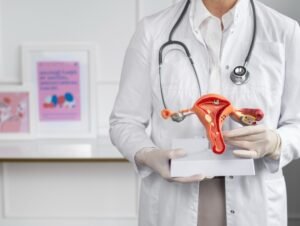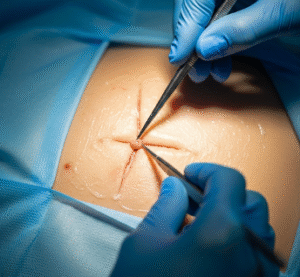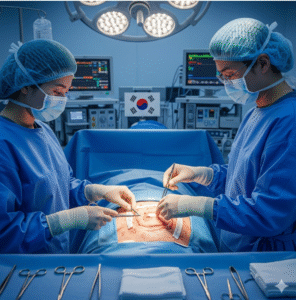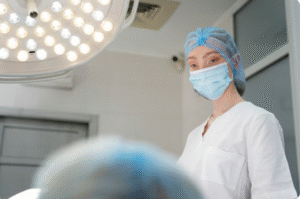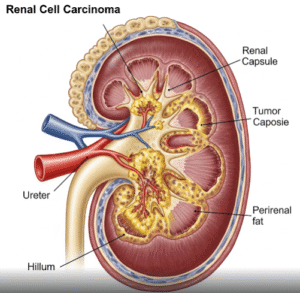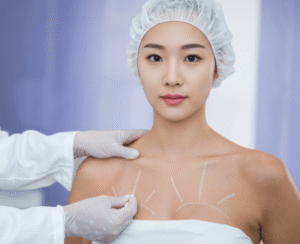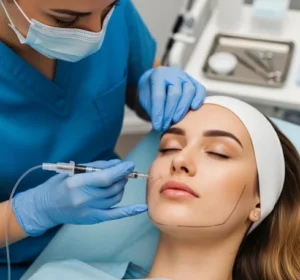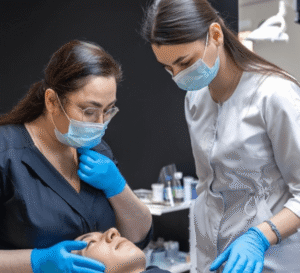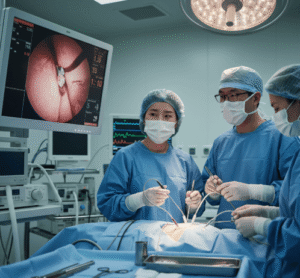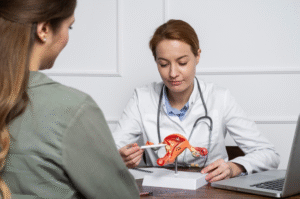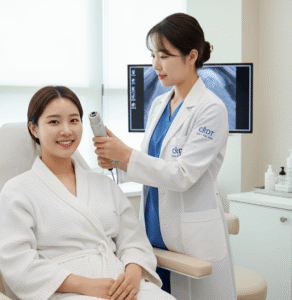What It Is
Breast fat grafting (also called autologous fat transfer to the breast) is a cosmetic surgery that uses the patient’s own fat—harvested from areas like the abdomen, thighs, or hips—to enhance breast size and shape. The fat is purified and injected into the breasts to create a fuller, natural appearance.
In Korea, breast fat grafting is a popular alternative to implants. Surgeons use advanced fat purification systems and microcannula injection techniques to improve fat survival, achieve smooth contours, and maintain a natural feel. It is often chosen by women who prefer natural augmentation without foreign materials.
Why It’s Done
Cosmetic Purposes:
- Increases breast volume naturally without implants.
- Improves breast symmetry and contour.
- Enhances subtle cleavage and projection.
- Provides a natural look and feel compared to implants.
Corrective Purposes:
- Restores breast volume after pregnancy, breastfeeding, or weight loss.
- Corrects deformities or irregularities after breast implant removal or lumpectomy.
Patient Considerations:
- Suitable for women with enough donor fat for harvesting.
- Popular among those seeking modest enhancement (1–1.5 cup sizes).
- Preferred by patients who want natural results without synthetic implants.
Alternatives
- Breast Implants (Silicone/Saline) – Provide more dramatic size increases but involve foreign materials.
- Hybrid Augmentation (Implants + Fat Grafting) – Combines implant volume with fat grafting for natural contouring.
- External Expansion Devices – Temporary tissue expansion to prepare for fat grafting (used in select cases).
- No Surgery – Padded bras or external prostheses for temporary enhancement.
Preparation
Patients preparing for breast fat grafting in Korea typically undergo:
- Consultation: Breast and body contour evaluation, goal setting, and 3D simulations.
- Donor Site Assessment: Areas like abdomen, thighs, or flanks identified for liposuction.
- Medical Screening: Bloodwork, mammogram (for older patients), and health review.
- Pre-Op Instructions: Stop smoking, alcohol, and blood-thinning medications.
- Fasting: Required 6–8 hours before surgery if performed under general anesthesia.
How It’s Done
Type: Minimally invasive surgery combining liposuction and fat transfer.
Duration: 2–4 hours.
Procedure Steps:
- Fat is harvested from donor sites using gentle liposuction.
- Fat is purified to remove oil, blood, and damaged cells.
- Small incisions are made around the breast.
- Fat is injected in fine layers with microcannulas for even distribution.
- Breasts are sculpted to achieve natural contour and symmetry.
Anesthesia: Usually general anesthesia.
Hospitalization: Outpatient or 1-night stay, depending on case complexity.
Recovery
- First Week: Swelling and bruising at both donor and breast sites.
- Pain Management: Mild to moderate discomfort managed with oral medications.
- Downtime: Most patients return to daily activities in 5–7 days.
- Exercise: Avoid strenuous activity for 3–4 weeks.
- Final Results: Stabilize within 3–6 months after fat settles.
- Longevity: Some fat reabsorbs naturally; the surviving fat remains permanently.
Possible Complications
- Swelling, bruising, or discomfort at donor and recipient sites.
- Partial fat absorption (commonly 30–40%).
- Asymmetry or irregularities (touch-up sessions may be required).
- Rare risks: infection, fat necrosis, or cyst formation.
- Microcalcifications on mammograms (usually distinguishable from cancer).
Treatment Options in Korea
Diagnosis
- Physical Examination for breast size, skin elasticity, and symmetry.
- Donor Site Evaluation to ensure adequate fat for harvesting.
- Imaging (Ultrasound/Mammogram) for patients over 40 or with family history of breast cancer.
Medical Treatments
For patients not ready for surgery:
- Non-surgical options are limited (external padding or bras).
- PRP or skin boosters may improve skin quality but do not increase size.
Surgical or Advanced Therapies
- Standard Breast Fat Grafting: For modest volume enhancement.
- Hybrid Breast Augmentation: Combination of implants and fat grafting for natural cleavage and contour.
- Reconstructive Fat Grafting: Used in patients after mastectomy, lumpectomy, or implant removal.
- Revision Fat Grafting: Corrects irregularities or asymmetry from previous surgeries.
Rehabilitation and Support
- Follow-up visits to monitor fat survival and breast healing.
- Lymphatic massage and scar care therapies (offered by many Korean clinics).
- International patient services: multilingual staff, airport pickup, recovery assistance.


